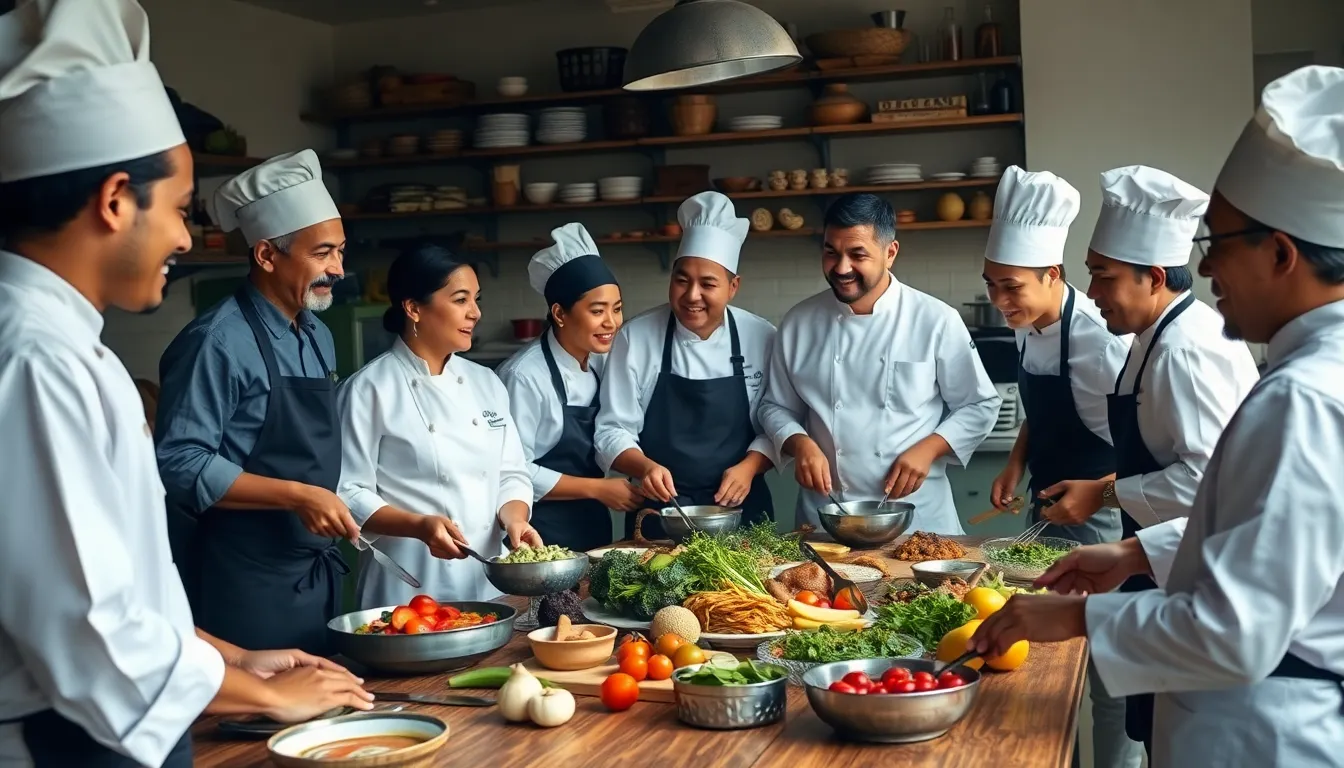Table of Contents
ToggleFood isn’t just a necessity; it’s an adventure waiting to unfold on your plate. Culinary delights are the magic that transforms simple ingredients into mouthwatering masterpieces. From tantalizing spices that dance on the tongue to decadent desserts that make you weak in the knees, the world of cuisine offers a treasure trove of flavors that can whisk anyone away to gastronomic heaven.
Overview of Culinary Delights
Culinary delights encompass a vast array of flavors, techniques, and presentations. Various cuisines around the world exemplify the rich tapestry of culinary artistry. Ingredients such as herbs and spices play a crucial role, enhancing dishes with unique characteristics. Each culture contributes distinct elements, creating a diverse and delectable global menu.
Individual components of a meal combine to create memorable dining experiences. For instance, savory fusions can be found in Asian street food, while classic Italian dishes showcase rich, homemade sauces. Desserts, too, take center stage, with indulgent creations like French pastries and American cheesecakes offering sweet escapes.
Processes like fermentation and smoking add layers of complexity to flavors, elevating standard offerings. Cooking methods vary greatly, influencing not just taste but also texture and aroma. Grilling brings out smoky notes, while baking develops a warm, comforting quality in desserts.
Events centered around food, such as culinary festivals and farmer’s markets, celebrate these delights. Chefs often showcase innovative dishes that transform traditional recipes, inviting diners to explore new tastes. Cultural significance also underlines the importance of certain dishes during holidays and special occasions.
Overall, culinary delights represent more than just sustenance. They embody a connection to culture, history, and community, making every meal an opportunity for exploration and enjoyment. The journey through diverse culinary landscapes encourages individuals to savor not just the food but the stories behind it.
Historical Significance

Culinary arts reflect a rich tapestry of history and culture. The evolution of food practices showcases the connection between cuisine and society.
Cultural Influences
Culinary traditions derive from historical events, migrations, and exchanges. Ancient trade routes facilitated the spread of ingredients like spices, impacting regional flavors. Many cultures incorporate their unique agricultural practices, creating distinctive dishes. African, Asian, and European influences merge in various cuisines, enriching the global palate. Celebrations often highlight local ingredients, emphasizing the importance of community ties. Different cultures adapt and transform recipes to fit their tastes, ensuring that dishes evolve continually.
Evolution of Cuisine
The evolution of cuisine corresponds with societal changes over centuries. Innovations in cooking techniques, such as roasting and stewing, revolutionized meal preparation. Industrialization brought about mass production, altering ingredient availability and food preservation methods. Globalization accelerated this evolution, allowing cross-pollination of culinary ideas. Fusion cuisine illustrates this trend, blending flavors and techniques from diverse culinary backgrounds. As technologies advance, chefs and home cooks alike embrace these changes, resulting in exciting food trends such as molecular gastronomy. Historic recipes undergo reinterpretation, inviting new audiences to appreciate traditional foods.
Types of Culinary Delights
Culinary delights encompass a wide range of flavors and experiences that reflect local and global traditions.
Regional Specialty Dishes
Regional specialty dishes showcase unique ingredients and cooking techniques specific to an area. Each cuisine highlights the flavors that define local culture. For instance, Southern US cuisine includes gumbo and jambalaya, while Italian cuisine offers risotto and osso buco. Mexican cuisine stands out with its tacos and mole sauce, showcasing rich, vibrant flavors. Distinct spices often elevate the dishes, infusing them with character. Exploring these specialties provides insight into the culture and history of each region, allowing diners to experience the authenticity of local gastronomy. Unique ingredients like locally sourced vegetables and traditional cheeses also play a critical role in defining these dishes.
Street Food Adventures
Street food adventures reveal the essence of culinary creativity and local life. Vendors prepare a variety of quick, delicious meals that capture the spirit of the region. Popular examples include Thai pad thai, Indian samosas, and Brazilian coxinhas. Each dish reflects the taste preferences of the local community while often being affordable and easily accessible. Uniting flavors, textures, and aromas, these foods invite patrons to savor unique offerings. Street food markets often foster social connections, allowing people to gather over shared meals. Exploring street food provides an exciting way to discover culinary treasures that might not be found in traditional restaurants. These experiences also enhance knowledge of diverse cultural practices centered around food.
Techniques and Preparation Methods
Cooking techniques and preparation methods form the backbone of culinary artistry. Understanding these methods enhances flavor and texture in dishes.
Traditional Cooking Techniques
Traditional cooking techniques emphasize time-honored practices that define cultural cuisines. Roasting transforms meats into savory delights, while simmering brings out the essence of soups and stews. Grilling imparts a smoky depth to vegetables and proteins alike, creating a wonderful char. Steaming preserves nutrients and flavors, enhancing health benefits in dishes. Baking crafts pastries, breads, and desserts, offering a comforting appeal that resonates globally. Fermentation adds complexity to ingredients, producing unique flavors found in items like kimchi or yogurt. Each of these methods highlights a cultural narrative woven into the fabric of culinary history.
Modern Innovations
Innovations in cooking techniques push boundaries and challenge tradition. Sous-vide allows precise temperature control for perfectly cooked proteins, which elevates restaurant-quality meals at home. Molecular gastronomy incorporates scientific principles, creating surprising textures and flavors. For example, spheres made of fruit juices create playful culinary experiences. Rapid marination introduces intense flavor in short time spans, offering convenience without sacrificing taste. Enzyme-assisted cooking enhances tenderization, making meats incredibly succulent. As technology advances, tools like air fryers and instant pots streamline meal preparation while retaining delicious results. Each innovation contributes to the evolving landscape of modern cuisine, inviting both creativity and efficiency in kitchen endeavors.
Culinary delights offer a vibrant tapestry of flavors and experiences that go beyond mere sustenance. Each dish tells a story and connects individuals to their cultural roots and shared histories. The exploration of diverse cuisines reveals the art of transforming simple ingredients into extraordinary meals, inviting everyone to savor the journey.
Whether indulging in street food or relishing regional specialties, the joy of culinary exploration fosters a deeper appreciation for food’s role in community and culture. As culinary techniques evolve and new trends emerge, the possibilities for creativity in the kitchen continue to expand. Embracing these delights not only satisfies the palate but also enriches the soul, making every meal an adventure worth savoring.










